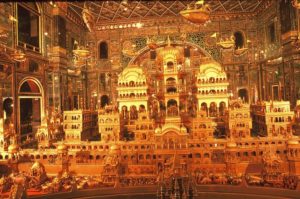Ayodhya, believed to be the birthplace of Lord Rama is one of the seven most sacred pilgrimage centers for Hindus. The city is located at the banks of the Sarayu River and was the capital of the ancient kingdom of Kosala. The city was known to be founded by the Hindu deity Manu and is believed to be 9000 years old.

Ayodhya
How to Reach Ayodhya
By Road : Ayodhya is connected to all other major cities in Uttar Pradesh via an excellent road network inside the state. Tourists can book a cab from any of the nearest major cities, including Faizabad (7 km), Allahabad (166 km), Lucknow (134 km), and Varanasi (134 km) (209 km).
By Train : Ayodhya is well connected to surrounding railway stations as well as major stations in northern India. The Northern Indian Railway’s wide gauge Mughalsarai-Lucknow route passes via Ayodhya Railway Station. The Lucknow Express, Varanasi Doon Express, and Delhi Faizabad Express are all daily trains.
By Bus : The Faizabad Bus Stand is the closest bus station to Ayodhya, with UPSRTC (Uttar Pradesh State Road Transport Corporation) buses running daily to Lucknow, Gorakhpur, Allahabad, and other major Uttar Pradesh cities. The cost of a cycle rickshaw from the Faizabad Bus Stand to the train station is roughly INR 30.
Best Time to Visit
Throughout the year, the weather in Ayodhya is mainly pleasant. During the summer and winter seasons, there are sporadic heat waves and cool breezes. The greatest time to visit, though, is from October to December, when the weather is pleasant and the events are plenty.
Food of Ayodhya
Food options in Ayodhya are restricted, as the town is a major religious centre, and only vegetarian cuisine is provided. There aren’t many fine dining establishments in Ayodhya, either.
Punjabi, North Indian, and Chinese cuisines are available in the few local eateries and Dhabas. The state’s Chaat, which comprises Aloo Tikki, Pani Puri, Kachori, Papri Chaat, Samosa, and others, is recognised for its colour and flavour.
Places to Visit
1. Kanak Bhavan
Kanak Bhavan, which is also known as Sone ka Ghar (House of gold) was built in the 19th century. The temple is situated in the centre of Ayodhya and is visited by a number of travellers. Kanak Bhavan is devoted to Lord Ram and his wife Sita.
It is believed that Rani Kaikey built this bhavan for Sita and it has been subsequently restored time and again by various kings. One of the main attractions of this temple is the musicians who perform in the white and black tiled courtyard. It is believed that the temple was constructed in 1891 by Rani Krishnabhanu Kunwari of Orccha.
The bhavan also has statues of Lord Ram and Sita in the inner sanctum. Apart from being embellished with gold ornaments, the images also wear gold crowns. Moreover there is a plague written on the outer wall of the temple, which states that there were many palaces on this site since the Treta Yuga
2. Treta Ke Thakur
Treta Ke Thakur refers to an ancient temple located at the banks of the Sarayu River in Ayodhya. The temple is said to house the idols of Lord Ram which was carved in the ancient times out of black sandstones. The place is considered to be the spot where lord Ram performed an Ashwamedha Yagya.
3. Gulab Bari
The monument is located in Faizabad near Ayodhya and is the tomb of the Nawab Shuja-ud-daula. The name Gulab Bari is due to the various rose gardens which are located by the water fountains that adorn the place. The architecture is a cross between the Hindu and the Mughal style often described as the Nawabi style.
4. Kanak Bhawan
The spot at which the temple is built was considered to house another temple which was gifted to Sita immediately after her marriage by Lord Ram’s step mother Kaikeyi. The temple was later renovated by King Vikramaditya of the Paramara dynasty and again rebuilt in 1891. Kanak Bhawan is one of the most elaborately detailed places in Ayodhya and the architecture is marvelous.
5. Hanuman Garhi
One of the most famous temples in Ayodhya, Hanuman Garhi is dedicated to the mighty Monkey God Lord Hanuman and was built by the Nawab of Awadh. The temple is characterized by the 70 steep steps that should be scaled in order to reach the temple complex. The temple is best visited during any major Hindu festival.
6. Moti Mahal
One of the fine specimens in Mughal Architecture, the Moti Mahal was the residence of wife of Nawab Shuja-ud-daula and was constructed in 1743 AD. The palace is situated in the nearby town Faizabad and is famous for its unique architecture and is frequented by many tourists.
